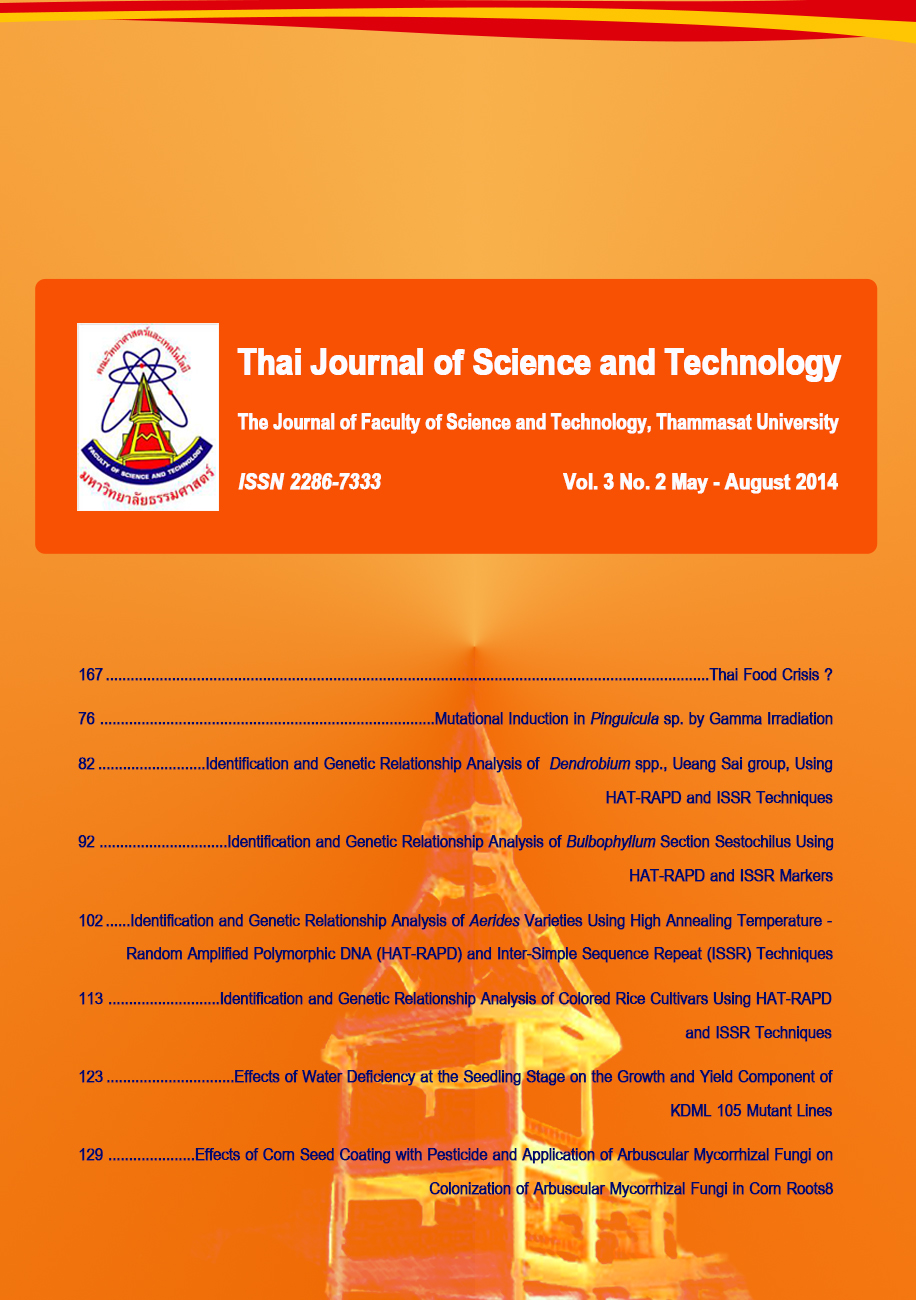การจำแนกและวิเคราะห์ความสัมพันธ์ทางพันธุกรรมของกล้วยไม้สกุลสิงโตกลอกตาหมู่สิงโตสยามด้วยเครื่องหมายแฮตอาร์เอพีดีและไอเอสเอสอาร์
Main Article Content
Abstract
บทคัดย่อ
สิงโตกลอกตา (Bulbophyllum) เป็นกล้วยไม้สกุลใหญ่ อยู่ในวงศ์ Orchidaceae พบได้ในป่าเขตร้อน ปัจจุบันกล้วยไม้กลุ่มนี้ลดปริมาณลงอย่างรวดเร็ว อีกทั้งการจำแนกกล้วยไม้กลุ่มนี้ด้วยลักษณะสัณฐานนั้นทำได้ยากและต้องใช้ความเชี่ยวชาญ ดังนั้นจึงมีความจำเป็นที่จะต้องศึกษาความหลากหลายทางพันธุกรรมและสร้างลายพิมพ์ดีเอ็นเอเพื่อใช้จัดจำแนกชนิดและพันธุ์ในระดับโมเลกุล ซึ่งสามารถใช้วางแผนการอนุรักษ์และปรับปรุงพันธุ์ต่อไป โดยศึกษาความสัมพันธ์ทางพันธุกรรมของกล้วยไม้สกุลสิงโตกลอกตากลุ่มสิงโตสยามที่พบในประเทศไทยจำนวน 12 ชนิด ด้วยเทคนิคแฮตอาร์เอพีดีและเทคนิคไอเอสเอสอาร์ โดยในส่วนของเทคนิคแฮตอาร์เอพีดีใช้ไพรเมอร์แบบสุ่ม จำนวน 20 ชนิด และในส่วนของเทคนิคไอเอสเอสอาร์ ใช้ไพรเมอร์ไมโครแซทเทลไลท์ จำนวน 11 ชนิด พบว่าเทคนิคแฮตอาร์เอพีดีและเทคนิคไอเอสเอสอาร์ สามารถแยกความแตกต่างระหว่างชนิดได้ด้วยแถบดีเอ็นเอที่จำเพาะกับพันธุ์ นอกจากนั้นยังสามารถจำแนกชนิดได้โดยใช้ ไพรเมอร์เพียงชนิดเดียวสร้างลายพิมพ์ดีเอ็นเอ เมื่อวิเคราะห์ความสัมพันธ์ทางพันธุกรรมพบว่ามีค่าดัชนีความเหมือน 0.23-0.49 และ 0.16-0.49 ตามลำดับ เมื่อวิเคราะห์ความหลากหลายทางพันธุกรรมโดยใช้ข้อมูลแถบ ดีเอ็นเอของทั้งสองเทคนิคมาวิเคราะห์ผลร่วมกัน พบว่าสามารถจำแนกกล้วยไม้กลุ่มนี้ได้เป็น 5 กลุ่ม โดยมีค่าดัชนีความเหมือน 0.20-0.49 เมื่อเปรียบเทียบผลการวิเคราะห์ความสัมพันธ์ของแต่ละเครื่องหมายเทียบกับลักษณะสัณฐานพบว่าการใช้เทคนิคแฮตอาร์เอพีดีและเทคนิคไอเอสเอสอาร์ร่วมกันให้ผลดีที่สุด
คำสำคัญ : สกุลสิงโตกลอกตา; การจำแนก; ความสัมพันธ์ทางพันธุกรรม; แฮตอาร์เอพีดี; ไอเอสเอสอาร์
Abstract
Bulbophyllum is one of the largest orchids genus belonging to family Orchidaceae and well-known as tropical area plants. Nowadays Bulbophyllum are dramatically reduced and its morphological identification is much more difficult which requires skilled and experienced persons. So it is necessary to understand the genetic diversity and DNA fingerprinting of orchids to identify and classify correctly in the molecular level that lead to the plans for orchids conservation and breeding program in the future. In this study, 20 random primers of HAT-RAPD technique and 11 microsatellite primers of ISSR technique were used to study the genetic relationship among 12 species of Sestochilus section, member of Bulbophyllum found in Thailand. The result showed that HAT-RAPD markers and ISSR markers are able to make the differences among 12 species with specific DNA bands even by using as only one primer. A dendrogram constructing based on polymorphic bands showed genetic similarities among 12 clusters with the similarity coefficients ranging from 0.23 to 0.49 and 0.16 to 0.49, respectively. It also provides an analysis of genetic diversity using the DNA band of two markers analysis together. A dendrogram constructed showed genetic similarities among 12 clusters with the similarity coefficients ranging from 0.20 to 0.49 as well as the analysis of genetic diversity. Molecular markers and morphology comparative analysis found that using HAT-RAPD technique and ISSR technique analysis together give the best results.
Keywords: Bulbophyllum; identification; genetic relationship; HAT-RAPD; ISSR
Article Details
บทความที่ได้รับการตีพิมพ์เป็นลิขสิทธิ์ของคณะวิทยาศาสตร์และเทคโนโลยี มหาวิทยาลัยธรรมศาสตร์ ข้อความที่ปรากฏในแต่ละเรื่องของวารสารเล่มนี้เป็นเพียงความเห็นส่วนตัวของผู้เขียน ไม่มีความเกี่ยวข้องกับคณะวิทยาศาสตร์และเทคโนโลยี หรือคณาจารย์ท่านอื่นในมหาวิทยาลัยธรรมศาสตร์ ผู้เขียนต้องยืนยันว่าความรับผิดชอบต่อทุกข้อความที่นำเสนอไว้ในบทความของตน หากมีข้อผิดพลาดหรือความไม่ถูกต้องใด ๆ


